DODGE STRATUS COUPE 2005 2.G Repair Manual
Manufacturer: DODGE, Model Year: 2005, Model line: STRATUS COUPE, Model: DODGE STRATUS COUPE 2005 2.GPages: 396
Page 61 of 396

Memory reclining knob
When you fold down the seatback by using the memory
reclining knob, the angle of the seatback will be memo-
rized.
Pull the memory reclining knob and fold the seatback
down.Just by pushing the seatback up into position will lock it
in the memorized position.
G21C0870
Memory reclining
knob
G21C0880
SEATS, SEAT BELTS, CHILD RESTRAINTS AND AIR BAGS 61
3
Page 62 of 396
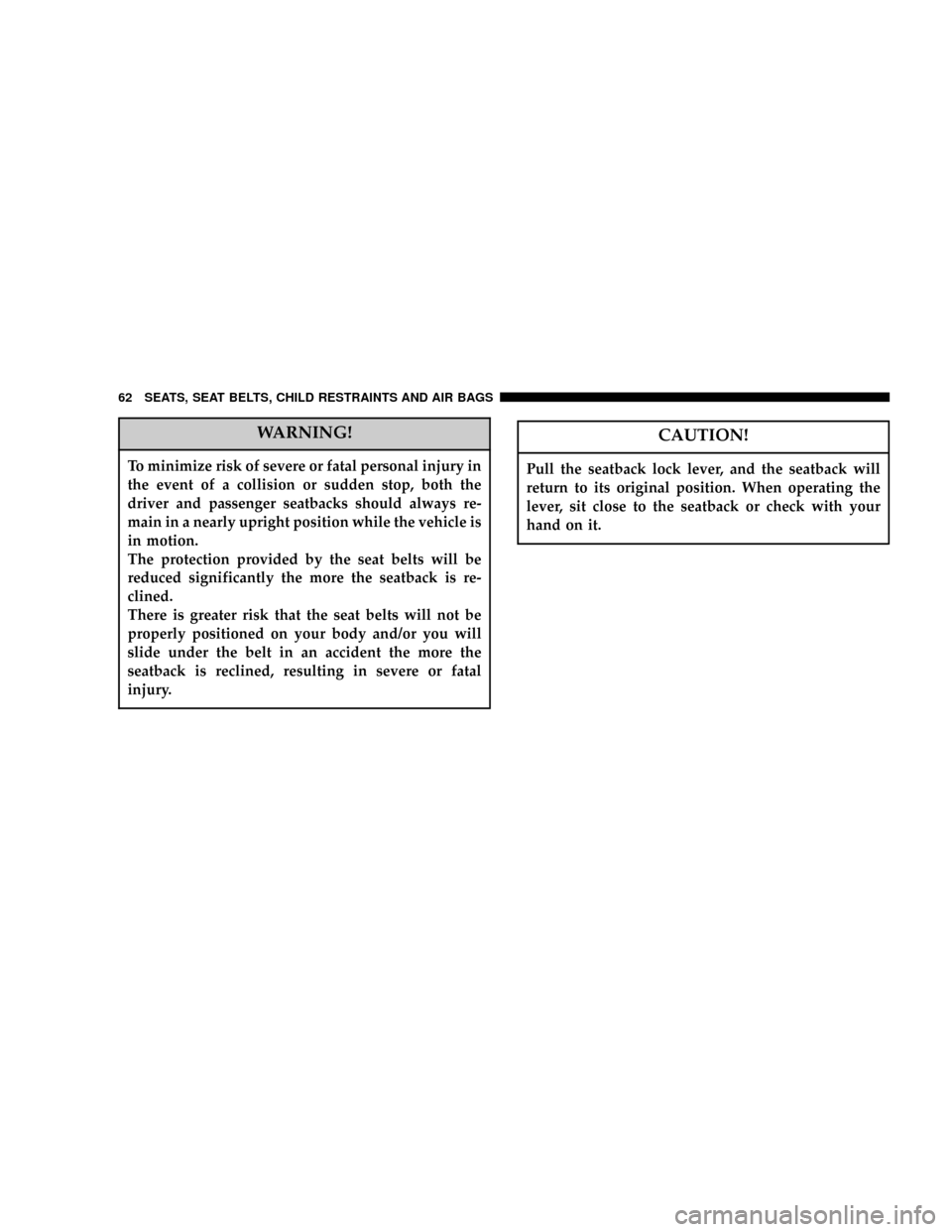
WARNING!
To minimize risk of severe or fatal personal injury in
the event of a collision or sudden stop, both the
driver and passenger seatbacks should always re-
main in a nearly upright position while the vehicle is
in motion.
The protection provided by the seat belts will be
reduced significantly the more the seatback is re-
clined.
There is greater risk that the seat belts will not be
properly positioned on your body and/or you will
slide under the belt in an accident the more the
seatback is reclined, resulting in severe or fatal
injury.
CAUTION!
Pull the seatback lock lever, and the seatback will
return to its original position. When operating the
lever, sit close to the seatback or check with your
hand on it.
62 SEATS, SEAT BELTS, CHILD RESTRAINTS AND AIR BAGS
Page 63 of 396
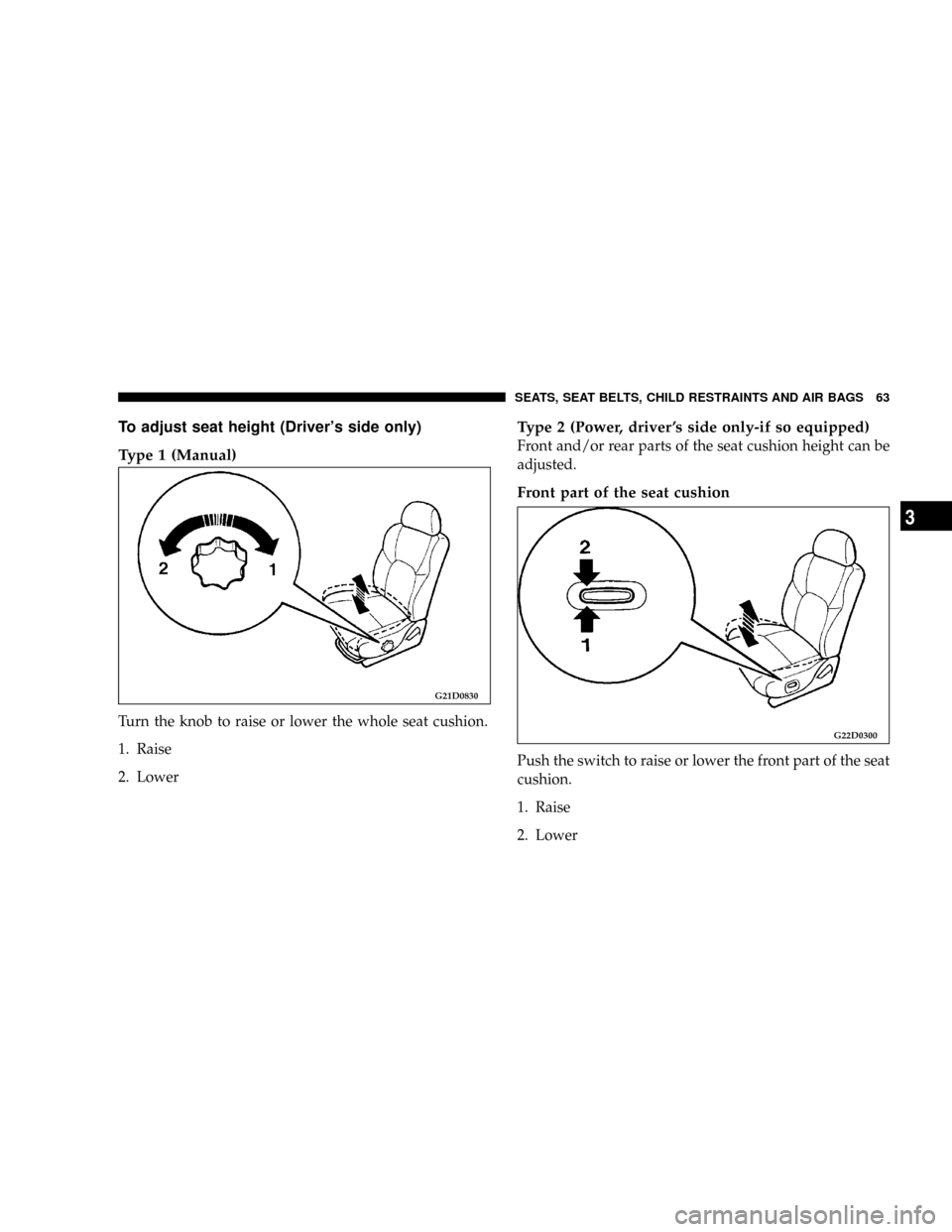
To adjust seat height (Driver's side only)
Type 1 (Manual)
Turn the knob to raise or lower the whole seat cushion.
1. Raise
2. Lower
Type 2 (Power, driver 's side only-if so equipped)
Front and/or rear parts of the seat cushion height can be
adjusted.
Front part of the seat cushion
Push the switch to raise or lower the front part of the seat
cushion.
1. Raise
2. Lower
G21D0830
G22D0300
SEATS, SEAT BELTS, CHILD RESTRAINTS AND AIR BAGS 63
3
Page 64 of 396

Rear part of the seat cushion
Push the switch to raise or lower the rear part of the seat
cushion.
1. Raise
2. Lower
Whole seat cushion
Push the center of the switch to raise or lower the whole
seat cushion.
1. Raise
2. Lower
G22D0310G22D0320
64 SEATS, SEAT BELTS, CHILD RESTRAINTS AND AIR BAGS
Page 65 of 396
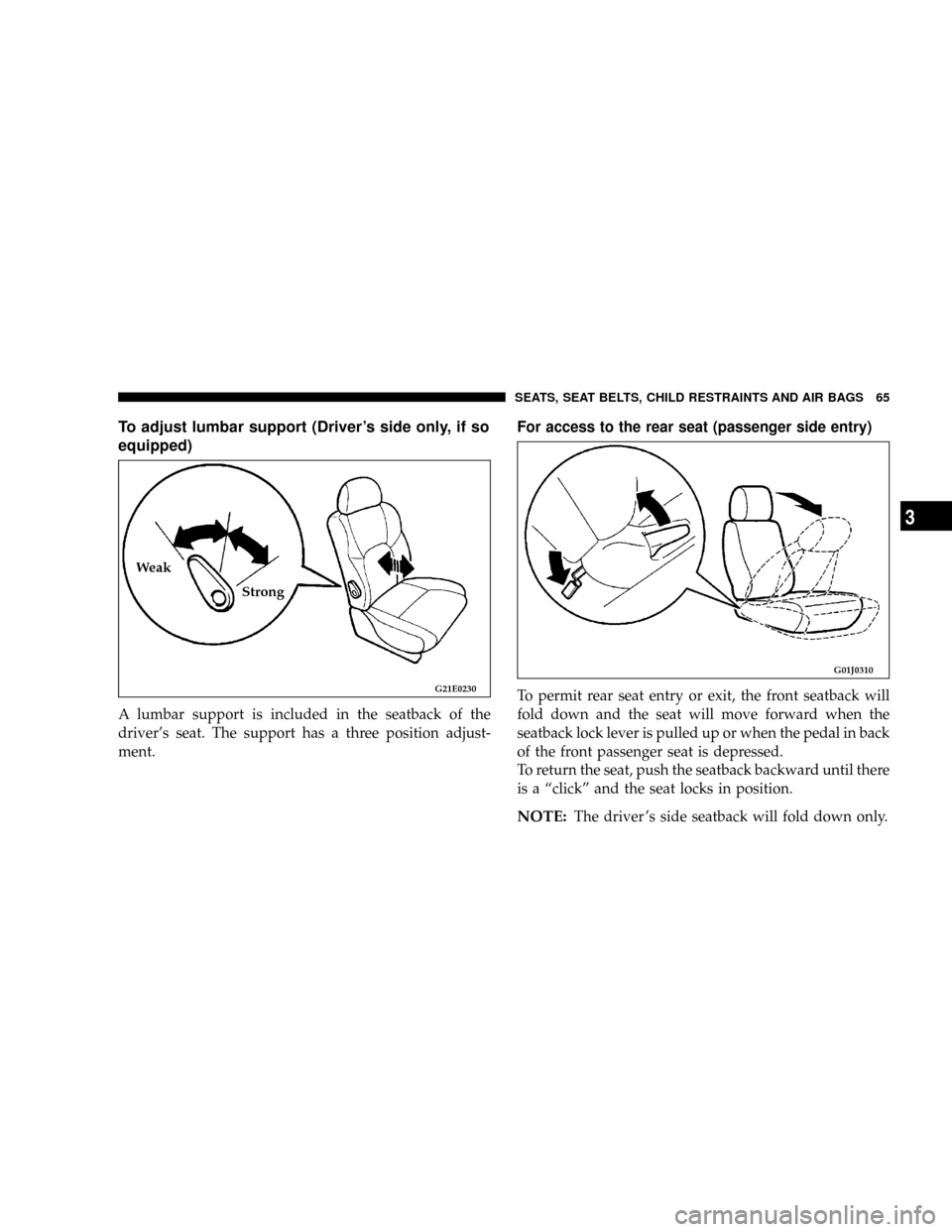
To adjust lumbar support (Driver's side only, if so
equipped)
A lumbar support is included in the seatback of the
driver's seat. The support has a three position adjust-
ment.For access to the rear seat (passenger side entry)
To permit rear seat entry or exit, the front seatback will
fold down and the seat will move forward when the
seatback lock lever is pulled up or when the pedal in back
of the front passenger seat is depressed.
To return the seat, push the seatback backward until there
is a ªclickº and the seat locks in position.
NOTE:The driver 's side seatback will fold down only.
G21E0230
Weak
Strong
G01J0310
SEATS, SEAT BELTS, CHILD RESTRAINTS AND AIR BAGS 65
3
Page 66 of 396

REAR SEATS
Rear seat capacity
WARNING!
²The rear seating capacity of this vehicle is three
people.
²The rear seat occupants should always wear their
seat belts when the vehicle is in motion.
Fold down rear seatbacks
The rear seatbacks can be folded forward to provide
additional cargo area.
Pull the left and/or right release knobs, and fold the rear
seatbacks forward.
HEAD RESTRAINTS
Padded head restraints for the front seats reduce the risk
of whiplash injury in the event of a rear impact.
G02C0750
G26A0140TLock knob
66 SEATS, SEAT BELTS, CHILD RESTRAINTS AND AIR BAGS
Page 67 of 396
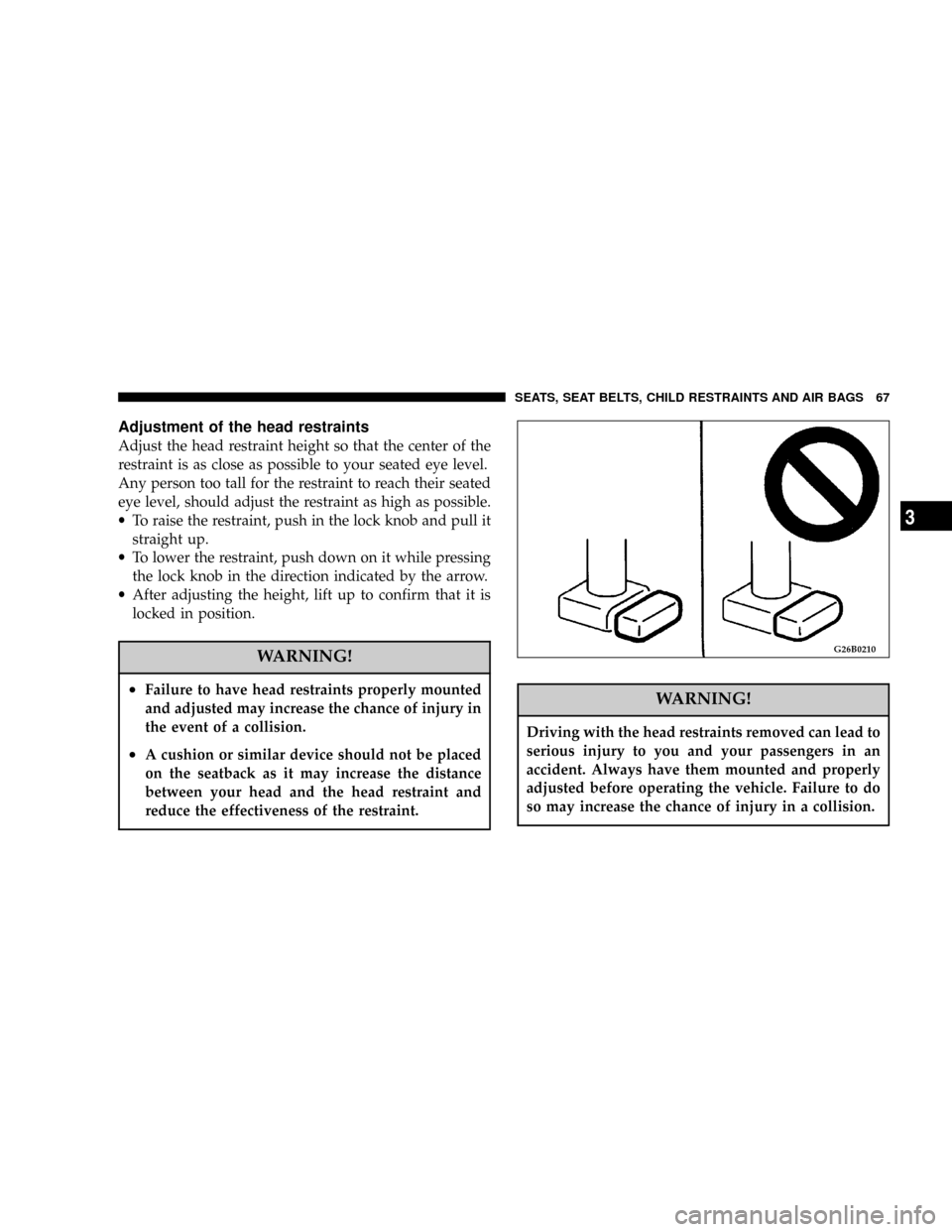
Adjustment of the head restraints
Adjust the head restraint height so that the center of the
restraint is as close as possible to your seated eye level.
Any person too tall for the restraint to reach their seated
eye level, should adjust the restraint as high as possible.
·To raise the restraint, push in the lock knob and pull it
straight up.
·To lower the restraint, push down on it while pressing
the lock knob in the direction indicated by the arrow.
·After adjusting the height, lift up to confirm that it is
locked in position.
WARNING!
²Failure to have head restraints properly mounted
and adjusted may increase the chance of injury in
the event of a collision.
²A cushion or similar device should not be placed
on the seatback as it may increase the distance
between your head and the head restraint and
reduce the effectiveness of the restraint.
WARNING!
Driving with the head restraints removed can lead to
serious injury to you and your passengers in an
accident. Always have them mounted and properly
adjusted before operating the vehicle. Failure to do
so may increase the chance of injury in a collision.
G26B0210
SEATS, SEAT BELTS, CHILD RESTRAINTS AND AIR BAGS 67
3
Page 68 of 396
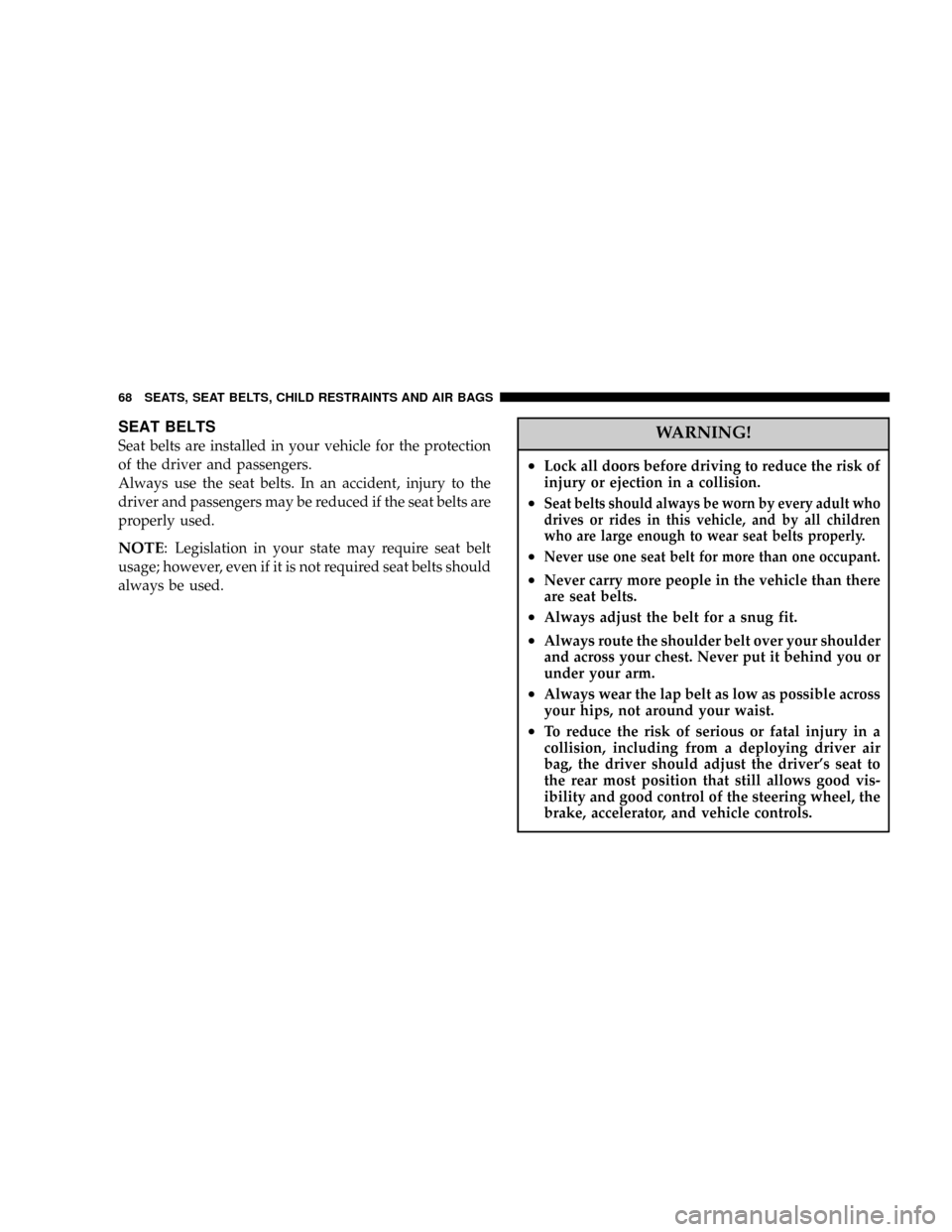
SEAT BELTS
Seat belts are installed in your vehicle for the protection
of the driver and passengers.
Always use the seat belts. In an accident, injury to the
driver and passengers may be reduced if the seat belts are
properly used.
NOTE: Legislation in your state may require seat belt
usage; however, even if it is not required seat belts should
always be used.
WARNING!
²Lock all doors before driving to reduce the risk of
injury or ejection in a collision.
²Seat belts should always be worn by every adult who
drives or rides in this vehicle, and by all children
who are large enough to wear seat belts properly.
²Never use one seat belt for more than one occupant.
²Never carry more people in the vehicle than there
are seat belts.
²Always adjust the belt for a snug fit.
²Always route the shoulder belt over your shoulder
and across your chest. Never put it behind you or
under your arm.
²Always wear the lap belt as low as possible across
your hips, not around your waist.
²To reduce the risk of serious or fatal injury in a
collision, including from a deploying driver air
bag, the driver should adjust the driver's seat to
the rear most position that still allows good vis-
ibility and good control of the steering wheel, the
brake, accelerator, and vehicle controls.
68 SEATS, SEAT BELTS, CHILD RESTRAINTS AND AIR BAGS
Page 69 of 396
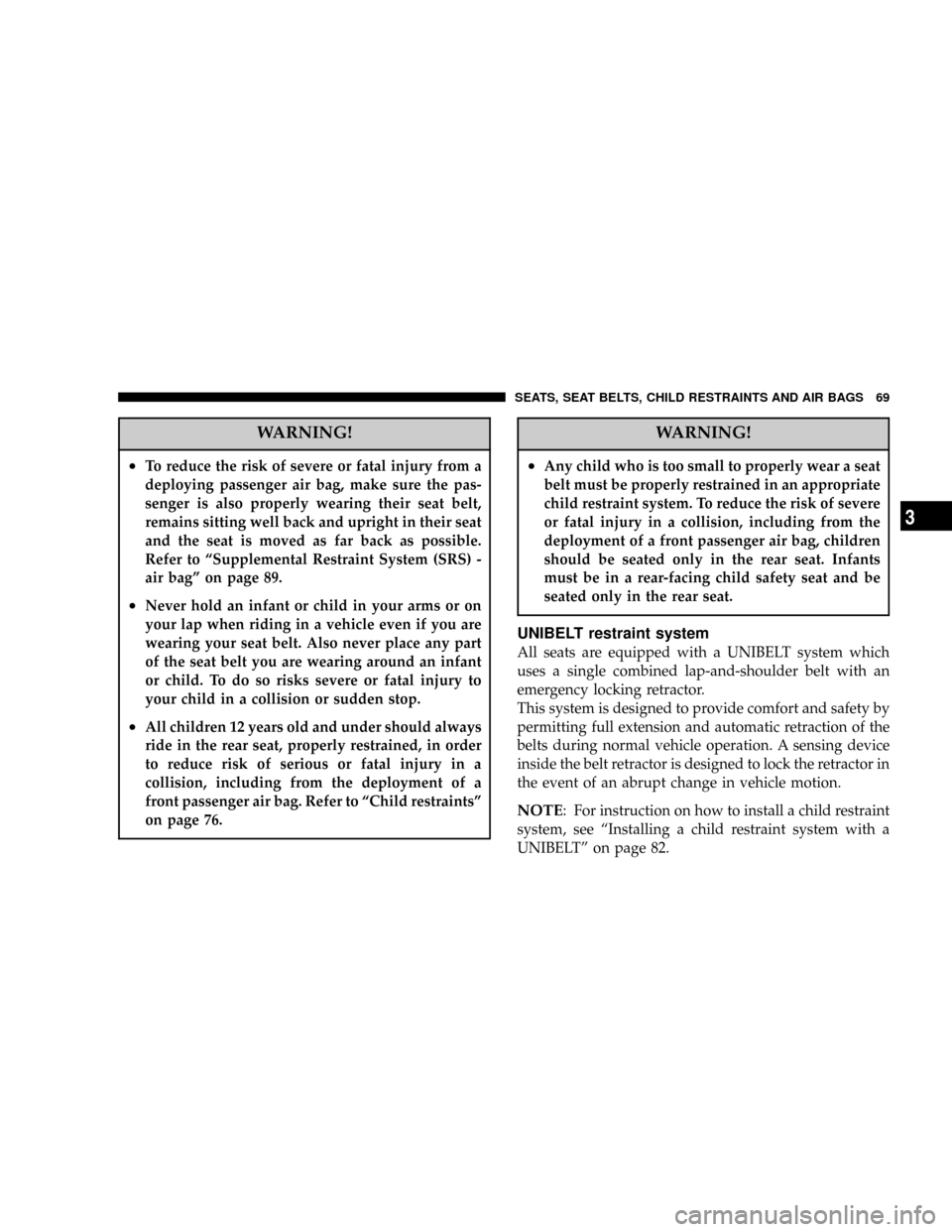
WARNING!
²To reduce the risk of severe or fatal injury from a
deploying passenger air bag, make sure the pas-
senger is also properly wearing their seat belt,
remains sitting well back and upright in their seat
and the seat is moved as far back as possible.
Refer to ªSupplemental Restraint System (SRS) -
air bagº on page 89.
²Never hold an infant or child in your arms or on
your lap when riding in a vehicle even if you are
wearing your seat belt. Also never place any part
of the seat belt you are wearing around an infant
or child. To do so risks severe or fatal injury to
your child in a collision or sudden stop.
²All children 12 years old and under should always
ride in the rear seat, properly restrained, in order
to reduce risk of serious or fatal injury in a
collision, including from the deployment of a
front passenger air bag. Refer to ªChild restraintsº
on page 76.
WARNING!
²Any child who is too small to properly wear a seat
belt must be properly restrained in an appropriate
child restraint system. To reduce the risk of severe
or fatal injury in a collision, including from the
deployment of a front passenger air bag, children
should be seated only in the rear seat. Infants
must be in a rear-facing child safety seat and be
seated only in the rear seat.
UNIBELT restraint system
All seats are equipped with a UNIBELT system which
uses a single combined lap-and-shoulder belt with an
emergency locking retractor.
This system is designed to provide comfort and safety by
permitting full extension and automatic retraction of the
belts during normal vehicle operation. A sensing device
inside the belt retractor is designed to lock the retractor in
the event of an abrupt change in vehicle motion.
NOTE: For instruction on how to install a child restraint
system, see ªInstalling a child restraint system with a
UNIBELTº on page 82.
SEATS, SEAT BELTS, CHILD RESTRAINTS AND AIR BAGS 69
3
Page 70 of 396

UNIBELT instructions
1. Get in the vehicle and sit in a normal correct posture.
To reduce the risk of severe or fatal injury caused by an
inflating air bag, adjust the driver's seat to the rear most
position that still allows you to fully apply the pedals,
easily control the steering wheel and safely operate the
vehicle. The front passenger should also adjust their seat
as far back as possible. Refer to ªSupplemental Restraint
System (SRS) - air bagº on page 89.All vehicle occupant's should sit and remain seated all
the way back in their seat with their back resting straight
against the upright seat back.
WARNING!
To minimize the risk of personal injury in the event
of a collision or sudden stop, both the driver and
passenger seatbacks should always be in a nearly
upright position while the vehicle is in motion.
The protection provided by the seat belts may be
reduced significantly when the seatback is reclined.
There is greater risk that the driver or the passenger
will slide under the belt and be seriously injured
when the seatback is reclined.
G28A0210
70 SEATS, SEAT BELTS, CHILD RESTRAINTS AND AIR BAGS